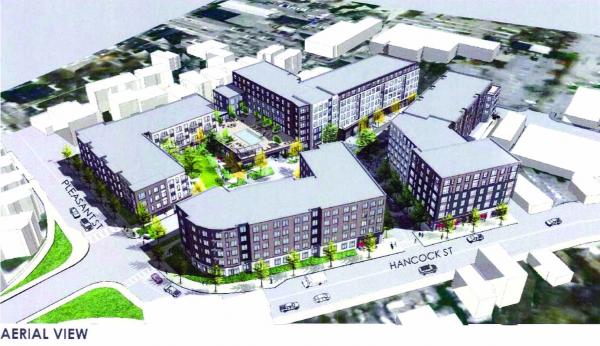March 20, 2019

An aerial view of the new design. Rendering from Stantec
After an extended comment period, the mixed-use Dot Block project at the heart of Glover’s Corner has a full mailbag tilting heavily in favor of approving the latest design. More than 150 discrete comments or statements of support were submitted between the start of February and March 15, along with about 60 in opposition. Ten commenters described themselves as neutral on the project.
A development team financed by the billionaire Gerald Chan is proposing four buildings with 488 residential units and amenities, around 23,000 square feet of “neighborhood-oriented retail and restaurant” space, an underground parking garage of 345 spaces, and about 1.34 acres of open space. The full parcel is roughly 4 acres off of Dorchester Avenue and Hancock Street.
Several local business owners and nonprofit members weighed in on the longstanding need to improve the disused lot, which was industrial space before demolition last year.
“This development is very important for our amazing Dorchester neighborhood,” wrote Kenneth Osherow, who owns several businesses, including McKenna’s cafe and Savin Bar and Kitchen. “Currently this area is a vacant wasteland filled with trash, drugs, and prostitution. The site is currently a depressing eyesore and a huge detractor from our neighborhood. We are in desperate need of additional residential housing, we need more working people in our neighborhood, and we need more options for retail, restaurants, and other neighborhood amenities.”
His comments were echoed by others, including Mary Kinsella of the Boys and Girls Clubs of Dorchester. She called the current site “in desperate need of change and improvement,” and is looking forward to the mixed-use project “drawing people into congregating and fostering a new and brighter community for everyone.”
On top of submitted comments through the BPDA website, some 70 people around the Dot Block area signed physical statements of support, which are included in the total comment tallies.
Said Columbia-Savin Hill Civic Association president Desmond Rohan of the project, which sits inside the association’s bounds, “Let’s make Dot Block happen. Our community is in need of housing and amenities and Dot Block will make a small difference in contributing to solving these problems.
“The project will be a catalyst for further investment in our community and its exciting. It’s great to finally see development in Dorchester,” he added.
A major link between objecting commenters was participation in pro-affordable housing and anti-gentrification groups like Dorchester Not For Sale (DN4S) and Dorchester People For Peace, which have objected to the overall affordability standards and the community process.
The development team is proposing about 20 percent of the apartments as compact units. Of the 66 income-restricted units, 24 are being offered at affordability levels below the Inclusionary Development Policy requirement of 70 percent area median income, including 45 percent, 50 percent, and 63 percent area median income options distributed proportionally across the varying types of units.
Mary Regan said the project should adhere to the DN4S standards they proposed at a public meeting attended by Mayor Martin Walsh. “After going through our own neighborhood process with Dorchester residents from the Vietnamese, Cape Verdean, Black, Latinx and White Working Class communities, residents have created a vision that includes the need for 65 percent of new housing within the complete Glover’s Corner planning area to be truly affordable to families making under $50,000 per year,” Regan wrote, adding that “13.5 percent affordable units in the Dot Block project is NOT enough.
“Our neighbors are being displaced every day,” she added. “The majority of the ‘affordable units’ in DotBlock are for people making 70 percent of the area median income, which is NOT affordable for most Dorchester residents. The AMI does not reflect the actual incomes of Dorchester residents.”
Fields Corner resident Angelina Hua of the DN4S echoed comments that she had made at a prior public meeting, citing the cultural richness of the area.
“Dorchester is my home and where families like mine can afford to live. Dorchester is where my Vietnamese community is,” she said. Hua was irked by the initial lack of Vietnamese translation at the public meetings and the speed of the community process to discuss the change of project proposal, adding, “There are people who want to join the conversation and give their input, as Dorchester residents who love Dorchester and are invested in the community, but cannot because there’s no translation.”
Members of civic associations whose territory does not directly include the Dot Block project offered mixed reviews.
Will Cole-French, president of the Hancock Street Civic Association wrote: “I believe this developer needs to go back and find the funding to double the number of affordable units for this proposed complex. The CPA [Community Preservation Act] funds are readily available and there may be other sources as well. While it is great that they have calculated the income formulas using data specific to the city of Boston, I would still like to see them go beyond the MINIMUM requirement for the total number of affordable units.”
Steve Bickerton, development chair at Cedar Grove Civic Association, wrote in support. “Glover’s Corner is in need of major investment and Dot Block will breathe new life into this long-neglected piece of property that will bridge Savin Hill and Fields Corner,” Bickerton said. “It’s imperative that a small group of vocal detractors not derail this project. This investment has been years in the making and it’s time to put shovels in the ground and create the jobs, housing, and economic opportunity that this development will bring!”
All 130 pages of comments can be found on the BDPA’s project page: bostonplans.org/projects/development-projects/dot-block. The next step for Dot Block is to return to the BPDA board at a time yet to be determined.



